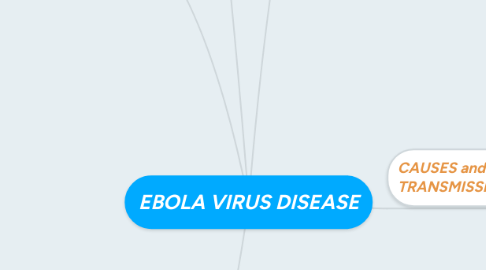
1. 2014 OUTBREAK
1.1. December 2013 : Apparition of the virus in Guinea
1.2. April 2014 : Expansion of the virus in Liberia and Sierra Leone
1.3. August 2014 : Expansion of the virus in the Nigeria. In the four countries there are 2240 cases and 1229 death.
1.4. September 2014 : EVD in Africa is perceived as a threat to international peace and security
1.4.1. United Nation Security Council deployed emergency health mission
1.4.1.1. Stop the outbreak
1.4.1.2. Treat infection
1.4.1.3. Ensure provision of essential services
1.4.1.4. Preserve the stability of the region
1.4.1.5. Prevent further outbreak
1.5. March 2015 : 24 247 infected cases and 9 961 death cases in Nigeria, Senegal, Guinea, Liberia, Mali, Sierra Leone, Spain, United Kingdom and United States
1.5.1. 2014 outbreak killed more than the previous 25 EVD epidemics combined
2. CONSEQUENCES
2.1. Physical
2.1.1. Effects on the body
2.1.1.1. Initial infection : direct or indirect contact
2.1.1.2. Incubation Period : 2 to 21 days
2.1.1.3. Actual Disease
2.1.1.3.1. Day 1
2.1.1.3.2. Days 2-7
2.1.1.3.3. Crisis Point
2.2. Social
2.2.1. Children have lost one or both parents (16 600 in 2015 in Guinea, Liberia and Sierra Leone)
2.2.1.1. Increase the number of orphans
2.2.1.1.1. Need special attention and support
2.2.2. Women responsible for growing, trading, and cooking, the virus is a lot present in these sectors
2.2.2.1. EVD affects lots of women (74% in Guinea)
2.2.2.1.1. Unbalanced of the proportion women/men : social problem
2.2.3. Devastated and overcrowded health care systems
2.2.3.1. People can not be nurse properly anymore
2.2.4. All these consequences involve a loss of security and education
2.3. Economical
2.3.1. Loss of education
2.3.1.1. Loss of knowledges and work efficiency
2.3.2. Decrease of incomes
2.3.2.1. Increase of the poverty
2.3.3. Food insecurity
2.4. International
2.4.1. Virus can expand all over the world
2.4.1.1. Developed countries are well situated to respond
2.4.1.1.1. Strong healthcare systems
2.4.1.2. Problem for the security of the developing countries
3. TREATMENT
3.1. Currently no vaccine or cure for Ebola Virus Disease
3.2. Trial vaccines and medications are being tested at the present time
3.2.1. With a varying 40 - 90% mortality rate, EVD is particularly tricky to cure
3.3. Current Therapies
3.3.1. Diagnosise the infection as early as possible
3.3.2. Giving patient support
3.3.3. Preventing dehydratation
3.3.4. Keeping patient cool to mitigate the effects of the fever
3.3.5. Giving pain relievers
3.3.6. Monitoring oxygen levels and blood pressure
4. CAUSES and TRANSMISSION
4.1. Bats travel patterns accross Africa
4.1.1. Virus lives in fruits bats in Tropical Rainforests
4.1.1.1. Transmitted to human population through close contact with blood, sweat, secretions and other bodily fluids
4.1.1.2. Transmitted to other animals (monkeys, deers)
4.2. Weak healthcare sector and high density of population in Africa, so very quick propagation of the virus
4.2.1. Human to Human transmission (EVD is only contagious once symptoms begin to show)
4.2.1.1. Direct Contact
4.2.1.1.1. Broken skin, blood, mucus membranes
4.2.1.2. Indirect Contact
4.2.1.2.1. Environment contaminated with fluids
4.3. The virus lives on after death, and also can live in a man's sperm for up to 7 weeks if he gets cured of it
4.4. West African burial ceremonies in which mourners have direct contact with the body of the deceased (60% of the Guinea cases where linked to funeral practises)
4.5. Fear of the infection
4.5.1. A lot of Healthworkers are infected : 840 infected and 491 deaths in 2014
4.5.1.1. Healthworkers don't want to go to work because they are scared
4.5.1.2. Families hide infected family members from health workers and don't nurse them, or call people for traditional practises
4.5.2. Patients leave the treatment center too early
4.6. Poverty
4.6.1. Lack of employment
4.6.1.1. People have to travel across the border to find work
4.6.2. Hospital ressources for infection control such as isolation wards are non existent
4.7. High density of population
4.8. International indifference
4.8.1. 8 months and 1000 deaths passed before the Global Health Emergency was declared
5. WHAT IS IT ?
5.1. Formerly known as Ebola Haemorrhagic Fever
5.2. First appeared in 1976 in two separate outbreaks; Nzara, Sudan and Yambuku in the Democratic Republic of Congo
5.3. EVD is most commonly found in Tropical Central and West Africa
5.3.1. The disease comes from the Rainforest
